Happy Easter Giant Bomb! I'd say "I can't believe we're almost done with Q1 of 2016 already", but I've been falling back on that intro segue a lot recently. I might as well just talk about the weather (overcast and cool, though the temperature's been picking up of late) or throw in an incongruous humblebrag (I was the fifth to beat the new Giant Bomb Super Mario Maker level! Sixth if you count Jeff!).
Actually, what I really want to discuss here is this feature moving forward. I've got into this pattern of writing a huge text dump at the end of the week that covers everything, but the original plan was to write a lot of smaller articles, lists and reviews throughout the week and use this Sunday round-up to gather them in one place for more discussion. It would certainly make ZombiePie's job easier in collating my week's nonsense in his Community Spotlights, though I'd probably have to make this a Friday thing for that to have any effect. After today, rest assured that I'll be splitting my work into several bite-sized morsels across the week and not half a novel every Sunday.
But that's next week, and we've got a lot to get through here. Enjoy!
New Games!

It probably goes without saying, but next week is going to be wall-to-wall-eyed Oculus Rift shenanigans as we all don our headsets and fight Jeff Fahey in C-space and/or make telepathic love with Sandra Bullock. It really all depends on what software gets released for it. I'm keeping out of the way of any specifics so that Monday's all-day Giant Bomb stream will be a series of pleasant surprises. Actually, it's mostly because I don't expect any of these launch titles will be anything more substantial than demonstrative tech demos. Launch libraries are rough enough without the amount of necessary "here's how all this shit works" proof of concept non-games to show newcomers the ropes. In that respect, I admire Oculus Rift for taking the brunt of that unenviable orientation work; the PSVR and HTC Vive won't have to make quite so much of a case for the format and can go ahead and make actual games for their respective LeForge headgears. Still, we might see something tomorrow that could persuade us to invest in VR - it'll be a difficult sell, but for all we know this might be the future of gaming. Or it might be 3D TVs. But hey, whether it's a new Renaissance in game design or an enormous burning trainwreck, either will be fun to rubberneck at for a few hours.
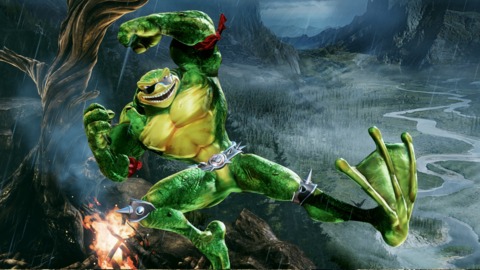
As for non-VR games this week, we have the dawn of another potentially irritating fad with Miitomo: Nintendo's mobile-enhanced variant of Tomodachi Life's "Miis do and say the darndest shit". Well, from what I can gather, at least. People seem to be going nuts about it, so it's heartening to see a promising start with all this mobile NX stuff Nintendo has planned. If those guys get anything right, it's launching killer apps on the first go: Super Mario World, Super Mario 64, Super Monkey Ball, Wii Sports and... I guess Nintendo Land? Well, they usually land on their feet more often than not. We also have NightCry, the mysterious spiritual-successor to the Clock Tower series that was at one point called Project Scissors, which is also the name of a new reality TV show I'm pitching about barbers who murder each other with giant scissors. (NBC's helping to iron out some details.) NightCry's been delayed at least once and got a sizeable amount of its funding on Kickstarter, neither of which is usually a good sign, but there's always room for more dependable horror games out there; it's been a while since we had a good one (which I guess would be SOMA from last September? I need to do some catching up, clearly). Finally, Killer Instinct Season 3 drops this Tuesday, giving us an ultra combo of characters (Yeah? Yeah? C'mon IGN, pick up the phone) that includes a bunch of no-name deadbeats from Killer Instinct 2, a Keith David-less Arbiter which seems kinda pointless and Rash Battletoad, of the New Hampshire Battletoads.
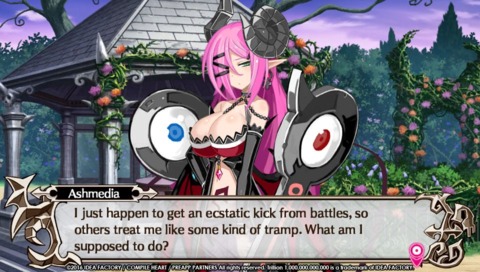
We also have some late-breaking JRPG news: Nights of Azure, from Gust, seems like a pretty but pretty generic action-RPG for the PS4. It sort of gives me a Chaos Legion vibe with its minions, so I don't know how I feel about that. There's also Trillion: God of Destruction, a Compile Heart game for Vita that appears to be biting the steez of NIS's Disgaea pretty hard; the player raises one of several female demon overlords to take on an all-powerful destructive force of pure chaos with, of course, one trillion HP. The longer you put off the grand showdown in order to get your Luciwaifu (Satanime? Let's not workshop this and say that we did) in fighting shape, the more of the Netherworld it'll devour.
Oh right, and we might see the PC version of Hyper Light Drifter out this week, specifically on Thursday. I'll believe that when I see it.
Wiki!
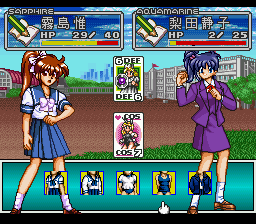
Busy week! Either I switched on the nitro (the... brain nitro) or there were a lot of uncomplicated games to describe, but I managed to spruce up twenty-eight pages in the past seven days. That covers February 24th to half of the games released on March 17th, a period of three weeks.
It's weird to put it in those sorts of terms though: three weeks of releases sounds like a lot of progress for one week of wiki-ing but there's seventeen more game pages to work on that were released between March 17th 1995 and March 23rd 1995 alone, so these SNES Wiki Projects tends to see more alternating fast-forward and slow-motion stretches than a Zack Snyder movie (and only slightly fewer murderous sorry, manslaughtering Supermen).
Of those twenty-eight, only six of those were brand new pages, which can you go read about over here. Here's a few highlights taken from the rest:
- Chrono Trigger: Yeah, guess what, I didn't have to do much for this page when it came up on the rota; as one of a handful of games to be lauded the greatest ever JRPG, its page has seen a lot of work already. I'd be loath not to mention it though, as it's easily the best game to come out of this three-week period.
- Lufia II: Rise of the Sinistrals: Lufia II narrowly beat Chrono Trigger to release, which might've saved its bacon. Making the unusual choice to go back in time and let the player take the "abilitease" party from the first game's intro before they reached that climactic opening battle, Lufia II was an odd mix of dungeon puzzles, monster-raising and isometric combat. It's a reputably good series, yet I've never been able to complete one (doesn't help that neither of the SNES games came out in Europe, or at least the part of Europe I give a crap about).
- Front Mission: Squaresoft managed to put out their inaugural wanzer SRPG shortly before Chrono Trigger as well, where it sold like gangbusters despite the amount of press that was focused elsewhere at the time. Enough mecha geeks bought it though, because it became one of Square's most enduring IPs. American fans wanting to climb into the first game in the series and walk around might be better off getting the DS port, since that received a North American release.
- Jelly Boy: My beloved Jelly Boy, a UK-developed SNES game I'll frequently champion alongside Plok and Equinox, is a platformer that essentially works the same as Claymates or A Boy and His Blob (except this time, the boy IS the blob!): every so often, you'll need to change shape to make progress. On a system full of platformer also-rans, many of which are based on licensed properties, Jelly Boy's a breath of fresh air with its great presentation and creativity.
- Magical Pop'n: A rare case of a frequently-imported Super Famicom game that isn't an RPG, like say Final Fantasy V or Live a Live or Mystic Ark or any Shin Megami Tensei game, Magical Pop'n's like a magical girl anime version of Mega Man X: there's a lot of non-linear exploration and judicious use of one's limited special powers in its level design.
- Captain Commando: Capcom are an odd bunch, and made an attempt to launch an IP with their own take on Konami Man: a badass masked superhero whose name conveniently abbreviates to CapCom. This brawler's best known in its Arcade incarnation, but the SNES home version doesn't lose much. As long as I can still play as the space mummy named "Mack the Knife" or the baby in a mech suit, I'm all set.
Not to be left out, here's some of the weird niche games from this period as well:
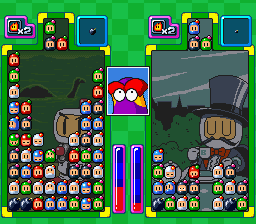
- Undercover Cops: Captain Commando wasn't the only Japanese brawler in this group. Undercover Cops is another semi-competent Arcade conversion of a near-future take on Streets of Rage. As well as being ridiculously strong, each of the game's three heroes - the classic brawler triumvirate of "slow and strong", "fast and weak" and "all-rounder" - has a few screen-clearing specials that only require a small health sacrifice. What becomes apparent when playing the game, either from its subdued color scheme or level of sprite detail, is that there's some connection to the Metal Slug games: the developers of Undercover Cops would soon depart Irem to form Nazca Corp, the creators of Metal Slug.
- Last Bible III: As in, Shin Megami Tensei: Last Bible III. Atlus's demon-summoning franchise has seen many spin-offs over the years - we saw one last time with Majin Tensei II - and Last Bible is perhaps one of the most elusive. It's the series's closest attempt at bridging the gap between itself and the more standard Dragon Quest/Final Fantasy mold, even placing itself in a vaguely steampunk fantasy universe reminiscent of FFVI (released the previous year).
- Nage Libre ~Seijaku no Suishin~: This thing is just weird. It's like Yu-Gi-Oh mixed with Fire Emblem mixed with a highschool dating sim. A group of interdimensional nymphs appear on a mysterious island that resembles an academy, and they all become highschool anime to deal with it. Then they fight each other for the chance to escape, but can also change their costumes mid-battle to a swimsuit or gym outfit for extra creeper cam goodness. Even if Nintendo was a beacon of wholesomeness, the Super Famicom sure saw a lot of anime cheesecake in its time.
- Otoboke Ninja Colosseum: A Bomberman clone, only with ninjas. They set bombs which fire shurikens in all four directions - the shurikens don't stop until they hit a wall, either, so there's no safe range. The story seems to involve a farting old man stealing a ninja scroll, and four lady ninja having to chase after it.
- Super Mad Champ: A motorcycle combat racing game, similar to Road Rash, only most of the art assets were taken from a Kunio-kun game (Renegade/River City Ransom) and if you get knocked off your bike, some hoodlum shows up to fistfight you. Lose the fight and he steals your bike, putting you out of the race. You can also get run over by other racers while you're brawling on the road to stop your bike getting jacked, which is just insult to injury.
- Love Quest: An RPG where every opponent is a woman and your weapons are your charm and wits. As in, you have to flirt with them until they are "defeated". You're ostensibly looking for your fiancee, who mysteriously vanished mid-wedding, but I get the impression that the hero isn't entirely the monogamous type. Weird and, given its reception from Japanese magazines like Famicom Tsuushin, kind of terrible. Nonetheless, a rare prototype cart of its Famicom version apparently sold at auction for 250k Yen (about $2,500), so I guess it must have its fans?
Where is My Heart?
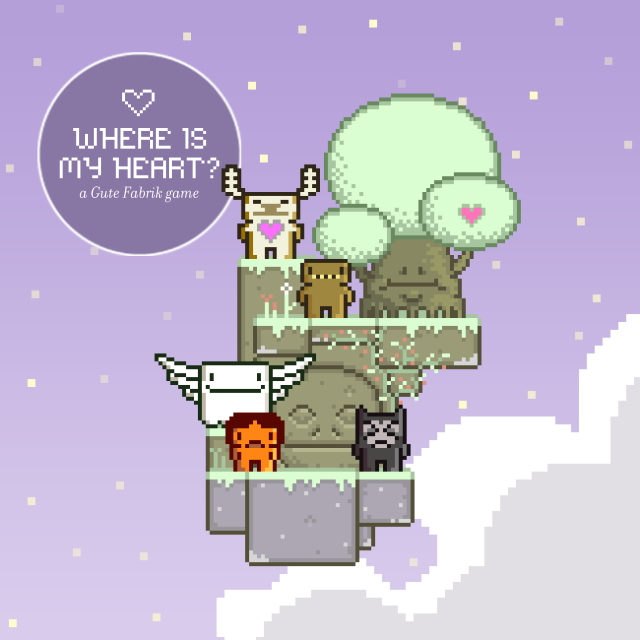
5% of this week's gaming was spent on Where is My Heart?, an Indie puzzle-platformer from Denmark, which introduces us to a family of three monsters - known simply by their colors Brown, Grey and Orange - and a world that becomes fractured due to... bad hearts? I'm not sure. The tale is a little obtuse, which fits well with its presentation and central gimmick (because every puzzle-platformer needs one) of having the stage split up into several windows which are then scattered around the screen. You can't rely on leaving one window to emerge on the one adjacent: more likely you've been teleported to the opposite side of the screen. The game does alleviate this discombobulation with a small amount of overlapping: if you walk far enough off the edge of a box, you can usually find where the next connecting area is. It's enough to stop you wandering into spikes and pitfalls, at least most of the time.
The other major theme of the game is the cooperation between family members. Each has their own contrasting personalities - Brown is a reckless and arrogant youth, Orange is a depressed lump and Grey is a cantankerous old man - yet they work together as a family unit, propping each other up to reach higher ledges and stacking to activate alter egos. The alter egos are what most of the game's puzzles are built around: the three characters are interchangeable on their own, but they're able to temporarily evolve into "ancestor" beings with unique gifts. Brown becomes the Antlered Ancestor, who is able to double-jump and turns the other two into fireflies that follow behind and revert back to normal when he does, which is easier than navigating the whole group across a stage. Orange becomes the Rainbow Sprite, who can rotate the screen's panels to make it easier to see the connections between them, and can also leap through space by staying put as the screen rotates around it. Grey becomes the Bat King, who is able to see the grim and disturbing world for what it truly is: this enhanced perception also reveals hidden platforms, offering more of the level to explore.
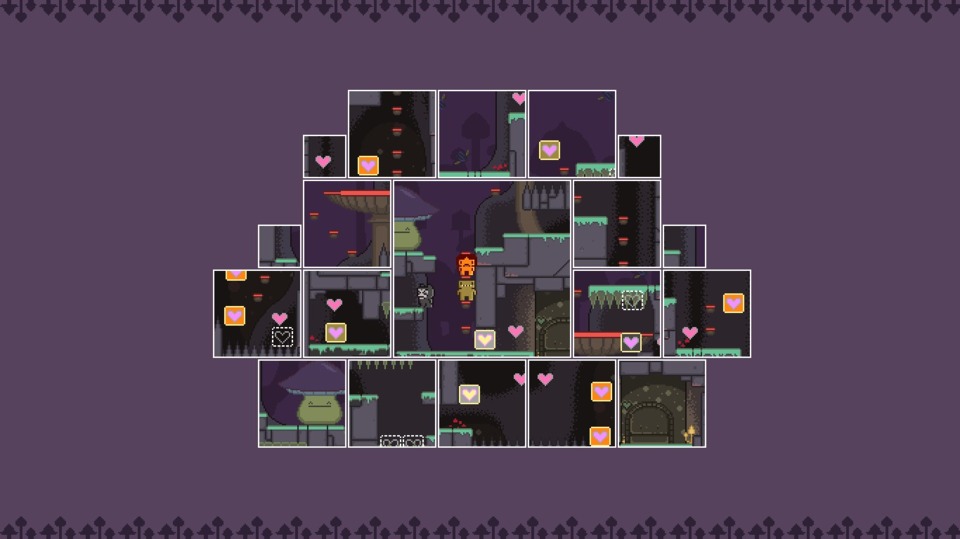
There's lots to appreciate here. The presentation, though once again reliant on pixel art, looks great and creates some nice effects when in either the Antlered Ancestor or Bat King forms, as they both perceive the world a little differently. It looks a lot better zoomed-out, where there's more details to appreciate. The game also picks the right time to bow out after a brisk twenty stages: the last four include the credits and three trickier bonus levels. It's often hard to ascertain the right end point, and I definitely believe that a game (especially puzzle games) should err on ending early than try to pad things out with repetitive instances for the sake of longevity, but I was happy to see the game conclude when it did, if only because I was about to pull my hair out during its last "proper" stage.
Which unfortunately means I must now address what it does wrong. While the game isn't too challenging, it exacerbates its "complete the level with no deaths for the best result" condition with how inaccurate certain elements of the game can be. Little annoyances, like how the Antlered Ancestor's fireflies have a mind of their own and will often cause cheap deaths when they decide to reform over deathtraps or inside walls during the second or so it takes the Antlered Ancestor to change back to Brown, or how the Rainbow Sprite will arbitrarily die if a certain amount of its hitbox is inside a wall when it teleports, or how each character emerges from the entrance a few seconds apart which makes replaying stages take far longer than is desirable. There's a specific reason for that last one: a later stage forces you to move them out of danger as soon as they emerge, but it's still a lot of unnecessary waiting for the majority of the stages. There's also no easy way to restart the level if you're trying to clear it without dying, besides exiting to the level select screen and re-entering it. These mishaps would've been difficult things to notice during the game's creation (though presumably easier to spot during playtesting), but they still serve to sour the overall experience.
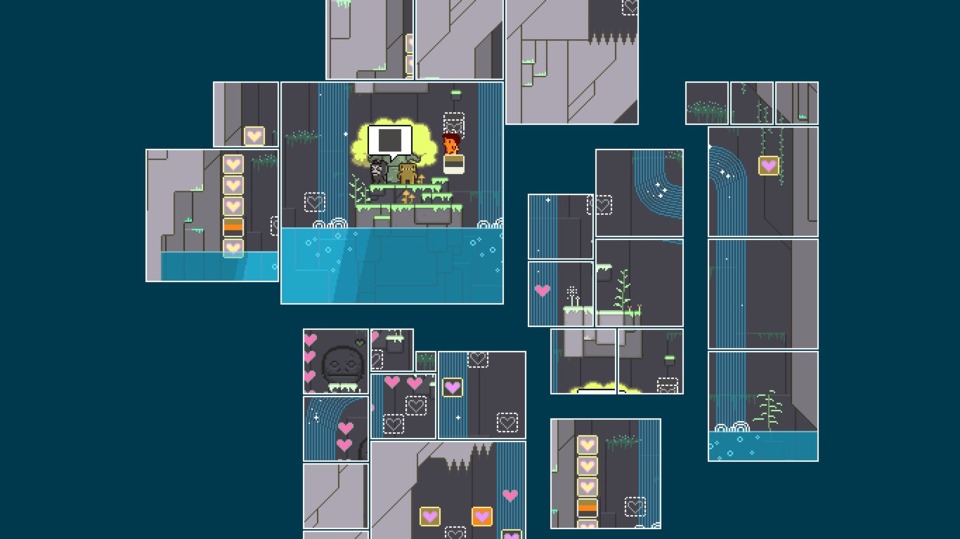
Overall, if you have this game sitting in your Steam library because of some bundle or other and have a few hours free, I'd recommend checking it out. It has a bizarre sense of humor, plenty of creativity, and a mystique to its story that is never fully explained, especially with its weird ending, so it's worth a look for those aspects at least. Maybe don't bother trying to go for a full no-deaths run though, as there's no payoff and it's only going to cause frustration when one of those three little guys decides to off themselves apropos of nothing. You have so much to live for, Orange!
The Witcher 3: Wild Hunt!
The Witcher 3: Wild Hunt is the other 95% of what I've been up to gaming-wise this week. I'm somewhere in the region of 20-30 hours in and there's so much to talk about with CD Projekt RED's latest take on the adventures of Andrzej Sapkowski's Geralt of Rivia, so here's a list of bulletpoints to quickly run through. Any or all of these might be expanded upon for a later article on the game:
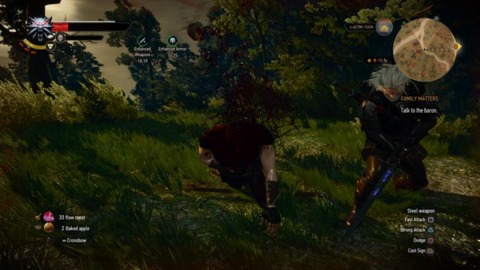
- Combat: Geralt's two swords. I don't recall if this was the case with The Witcher 2, but the game now automatically chooses the correct sword for you if you forget which is which and there's enemies nearby. They're each as important as the other, and it's therefore vital that both remain close to your level when it comes to buying/crafting new gear.
- Combat: Dodging vs. rolling. This is something I've only picked up relatively recently to my chagrin, despite the tutorial section of the game clearly demonstrating the two types of evasion. The essential difference is that dodging a blow keeps you in the fight by only moving you slightly out of the way of the enemy's blow, allowing you to quickly close the distance for a counter combo. Rolling puts you far enough way that the enemy is ready to attack again once you're back within range. However, if the enemy is charging up for something unblockable or about to perform an area of effect ability and you need to get the heck out of there, the roll is perfect. To my credit, I did get the hang of parries pretty quickly - they work the same way they do in everything else, in that it's all down to careful timing.
- Combat: Geralt receives a crossbow fairly early on, during a tutorial mission against an aerial foe. As a weapon, it has very weak damage output without considerable enhancements, but still remains useful in certain situations. Mostly to knock down flying enemies, or aggro a member of a group away from the pack. What I like is that this is essentially what you use the crossbow for in The Last Story too. I can appreciate that you have to devalue what is, in reality, a very devastating weapon in order to keep the more in-depth swordfighting as the player's preferred approach, but I still like the idea of having a convenient means to distract enemies or bring them within reach.
- Combat: One last note on combat, because it isn't quite the same as Batman's or Souls's despite a few structural similarities. Geralt's physical prowess means he can chop away at a cornered foe without stopping - the stamina really only applies to rolls and Sign usage - but enemies often attack in groups. It becomes less about single-mindedly attacking a foe to bring down the number of combatants than it is to keep on the outskirts of the group, attacking anything that gets in range before retreating a little to avoid being swarmed or surrounded. This has been a recurring aspect of the combat in every Witcher game, of course, but the vastly increased danger that group battles present in these games is still distinct to this series. Geralt really cannot take many hits, especially on the higher difficulties.
- Loot: The Witcher 3's loot game is on point, and by far my favorite thing about the game. In so many loot games, treasure generally falls under two categories: it's vendor trash that presents an additional step between you and more money, or it's incrementally better equipment with higher numbers and a prettier rarity color. Witcher 3 provides both of those but also offers a dizzying array of crafting materials, alchemy ingredients, food (healing) and other consumables, alchemy recipes, enhancement runestones to slot into equipment, crafting blueprints, sources of lore, and cards for its game-in-a-game, Gwent. The game has so much junk in it, and I couldn't be happier for an open-world RPG to present so much variation with its valuables: whether that's the kind that'll make you stronger in battle, make you richer or add new possibilities for combat buffs going forward. It's also very difficult to overload yourself: even purloining an entire Elven ruins of its lucre didn't quite over-encumber me, though it helped that I acquired some (free!) DLC saddlebags that tripled my initial inventory limit.
- Side-Questing: Very little filler with the side-questing. Each monster contract requires a bit of detective work and preparation before its centerpiece fights. Other side-quests have multiple stages, often taking you across the map and hours spent dungeoneering. Many more are incidental, jumping out as you're walking down a road and resolved almost as quickly as they appear.
- Anti-Obsessive Measures: I've never seen an open-world game do this, but The Witcher 3 adopts an odd experience gain system that discourages too much wandering off from story missions for random events on the map. Every story mission has a fixed difficulty and the game will refuse to let you surpass it. If you continue to do side-quests or kill monsters irrespective of the next objective in the main questline, you'll get fewer and fewer experience points for it. The game has balanced its story missions with great care and clearly wants you to stick to the adventure it has written for you, like an overly insistent Dungeon Master. That's not really a bad thing either; if Dragon Age Inquisition or Skyrim taught me anything, it's that I could use some reining in every now and then.
- Anti-Obsessive Measures: The game does actually throw you a bone if you're the type to have canvassed the Hinterlands as soon as you began Dragon Age Inquisition. The first area of the game is a smaller region that can be fully explored to the player's content. In fact, there's a lot of stat-boosting "Places of Power" in that first map that can really help a low-level Geralt. Once you hit the swampy and enormous region of Velen and find that half the encounters outside of immediate quests are way too tough, you can wise up and stick to the story missions for the first few hours of your stay there. You really have to be judicious and save frequently when exploring the game's many "locations of note" - which appear on the map as a scattering of question marks whenever you peruse a town or village's noticeboard for the first time - because it's not unheard of to find a bunch of low-level Drowner enemies (water zombies, basically), a group of mid-level bandits and a high-level spider-demon thing on the same stretch of road.
- Progression: Geralt can focus on any of his Witcher talents: combat, Signs or alchemy. All three seem fairly balanced, and all complement each other so there's no real min-maxing or worries about gimping your build (there's also potions you can buy that reset your skill points too, if the worst should happen). I'm trying to use my Signs more in this game - from what I can tell from reports on the higher difficulty levels, it's downright necessary for survival - so I've been putting the wolf's share of my points into Quen (a shield which nullifies any attack once, super useful) and Axii (stuns or charms enemies, depending on its specialization). I have lots of HP boosts on too - I get injured a lot.
- Signs: Speaking of Signs, these little guys are back and feel every bit as utilitarian as before. They remind me of a Knights of the Dinner Table arc where the guy who usually plays a fighter, Dave, decides to roll up a wizard instead. He builds the character like he would a fighter though, leaving him with a very low intelligence that means he can only use cantrips: basic little spells that are used for lighting candles and the like. Nonetheless, he manages to find ingenious combat uses for them and ends up becoming a useful member of the team. Likewise, The Witchers don't command magic as effectively as the sorceresses or mages of that universe, but the small array of basic spells they have provide all the additional support to their combat prowess that they need. As well as the above Quen and Axii, there's also the short-range fire projection Igni, the magical trap Yrden which is vital when fighting ghosts to trap them in their corporeal forms, and the telekinetic blast Aard which works wonders in group combat when you need to create some distance by knocking everyone down. It's easy to overlook those little guys, but they're all vital and Geralt can only do so much to keep himself alive through parrying and riposting.
- Difficulty: So, what I tend to do with games that offer achievements for higher difficulty levels is to play on the hardest difficulty and knock it down if it ever becomes too challenging. Yet even though I've let poor Geralt die numerous times playing The Witcher 3, occasionally losing more than a few minutes of progress since the last save, I actually prefer the game at this level of challenge. A single mistake could cost me dearly, but it feels the most congruous to how The Witcher ought to be (in my opinion, anyway): Geralt has to rely on grit and grace to defeat powerful monsters, and it makes little sense to the fiction if you're able to chop them down as easy as firewood. Not for everyone, but if you're about to start a new game I'd strongly consider doing the same tactic of setting that difficulty high and see if it's for you. The possibility is always there to lower it later.
- Alchemy: Once you've brewed a potion, your finite stock of them can be refreshed as many times as you'd like whenever you meditate with alcohol (man, I've been there). This prevents you from having to manually pick all the necessary plants for each new brewing. This works for oils and bombs as well: as long as you have the materials to concoct it the one time, you're all set. It's a great system that cuts down on unnecessary farming, though you still need to search far and wide for ingredients for that first batch.
- Alchemy: For battles, potions are super useful yet often also super conditional. There seems to be a single potion type for healing, and you only get three of those per rest: the best source of healing is regular food items, which you find anywhere but become increasingly less effective as you level up. The best potions are the "decoctions": these last for ages but have a high toxicity, which prevents you from taking too many at once. Bombs are highly useful too, not only when you have a group of enemies clumped together but when you're out destroying monster nests for the loot they contain.
- Monster Variety: Virtually every monster requires that you read their bestiary; each entry lists their weaknesses, including which Signs are the most effective, what oils and bombs do the most damage and what buffs you'll probably need to stick on (like elemental shields, or protection against poison) before aggro-ing one. You can get by with a mix of swords and dodge/rolls, but exploiting weaknesses makes each battle go way faster (and less painfully).
- Monster Variety: In addition, the monsters have different strategies, but these relate more closely to their groupings rather than a case-by-case. For instance, anything listed as a "necrophage" - drowners, ghouls, etc. - are fast and vicious group attackers, while anything classed as a ghost will regularly go immaterial and teleport behind you for ambushes. You get a sense for how a tough monster will fight with experience fighting weaker members of the same family.
- Gwent: I actually like Gwent. It's a variant of a basic "bigger number = win" card mini-game, but the special card abilities make it the right level of complex. It seems fairly easy to build a decent deck and railroad anyone in your way though. It's probably why every merchant looks so glum whenever you ask them for a quick game.
- Callbacks: Haven't played the first The Witcher, though I've been meaning to forever (ditto with S.T.A.L.K.E.R., which I only just started last year with Shadow of Chernobyl) but the game is lousy with Witcher 2 cameos and callbacks. Most of the same characters reappear in Witcher 3, at least in Gwent card form. It seems that only a few months have passed since the events of the second game, and I especially like how the player can reaffirm their choices in Witcher 2 with an optional interrogation early in Witcher 3. For the record: I let both Sile de Tansarville and Letho live, as well as the guy from the opening siege battle, and helped save Saskia from her curse. I'm sure Triss isn't stoked that I left her to be rescued by someone else in the last game, but I guess I'll hash that out with her when we meet in Novigrad.
- Glitches: As expected from an immense open-world from a relatively small(ish) team. Mostly visual bugs so far (see below), but there's also been some errant unreachable container placement and at least a few nastier progress-halt bugs, like in one situation where I couldn't dive underwater. One of my favorite bugs was when I died standing up. Geralt just put his sword away and shrugged a little as the screen faded to black.
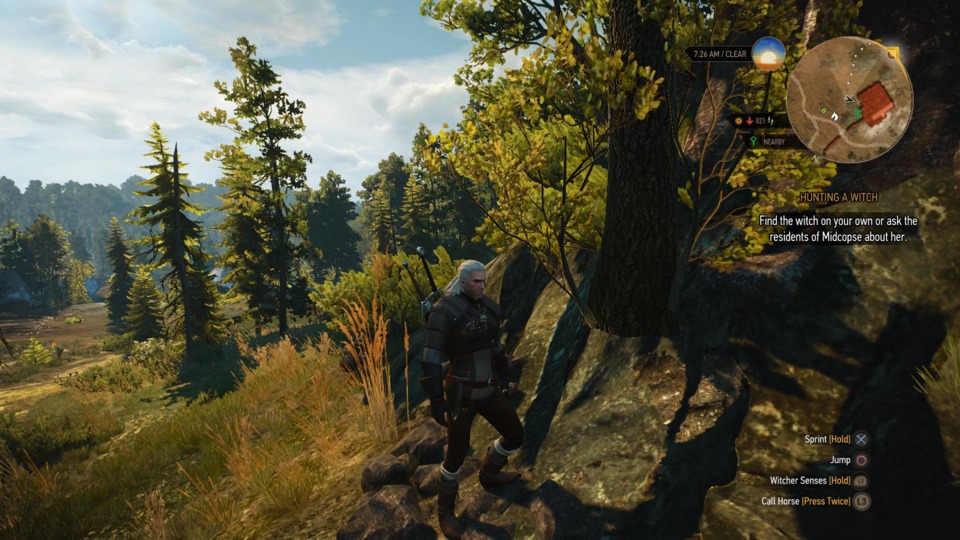
I'm not sure how or when I'm going to do anything more in-depth on The Witcher 3. Chances are that anyone who had an interest in that game has already caught up with it, so I might be all right to talk in detail about some of its story quests and side-missions, but I'd rather not alienate those who have yet to strap on their two swords for their own Witcherin' adventure. I'll be playing it for another week or two at least, though, so I'd better think of something. Maybe I'll play around more with combinations of signs, bombs, potions and oils and report on just how versatile the combat really is.
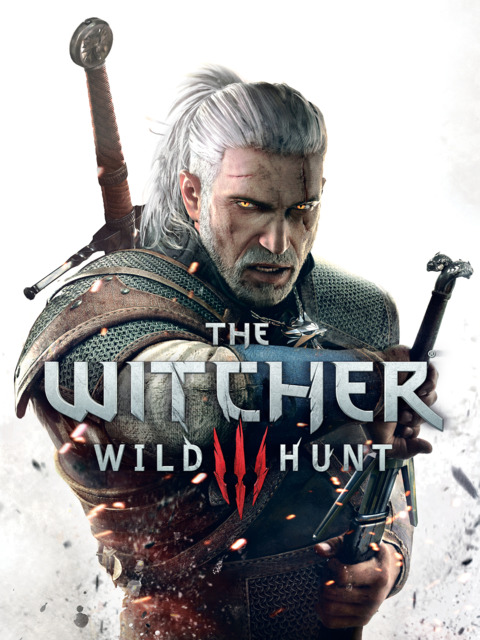
Log in to comment